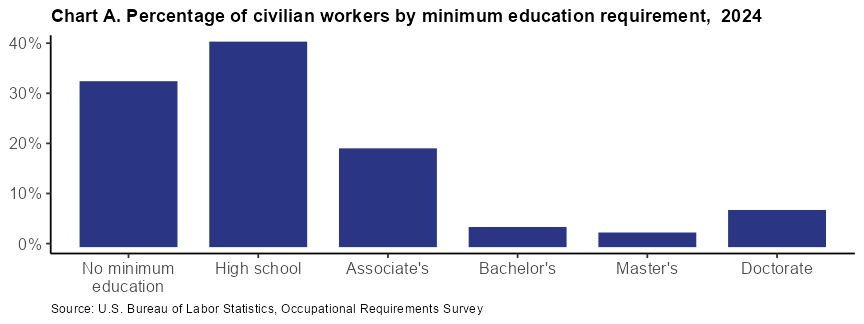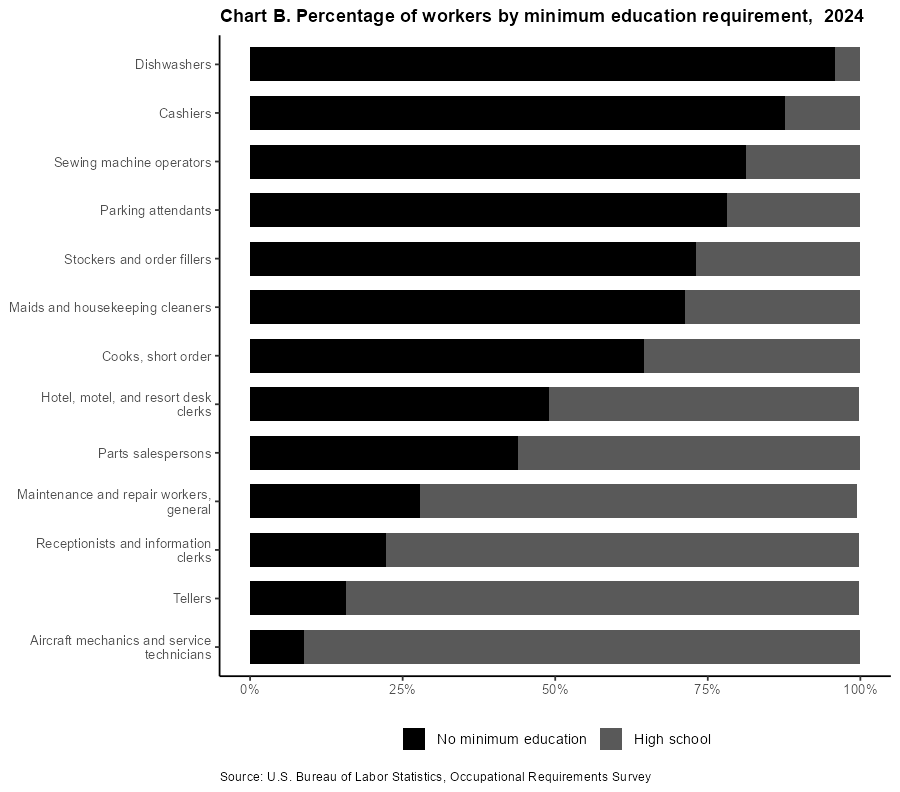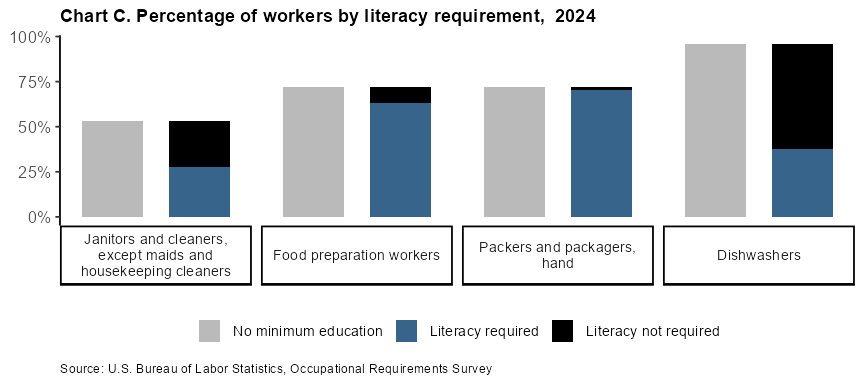An official website of the United States government
 United States Department of Labor
United States Department of Labor
The Occupational Requirements Survey (ORS) publishes job-related information on physical demands; environmental conditions; education, training, and experience; as well as cognitive and mental requirements. The job requirements reflect those necessary for workers to perform critical tasks in support of the critical job functions. The ORS provides information on the formal minimum education required to perform jobs, not the educational attainment of workers. For example: if a job requires a bachelor’s degree, but workers performing the job hold higher degrees such as a Ph.D., the estimates reflect the job requirement of a bachelor’s degree.
Minimum formal education requirements are one of four components used to calculate an occupation’s specific vocational preparation, or SVP. The SVP is determined by the amount of preparation time required by the job and includes credentials, prior work experience, minimum formal education requirements, and on-the-job training.
General education requirements are not included in SVP since they are not relevant to any specific occupation. The minimum formal education requirements and the vocational time included in the SVP are shown below:[1]
| Minimum education requirement | Vocational time included in SVP [1] |
|---|---|
|
No formal education required |
None |
|
High school |
None |
|
Associate's |
1-2 year |
|
Bachelor's |
2-3 years |
|
Master's |
All post graduate years (usually 1-2 years) plus 2 years of bachelor's |
|
Professional |
All post graduate years (usually 2-4 years) plus 2 years of bachelor's |
|
Doctorate |
6 years (4 years post-graduate plus 2 years of bachelor's) |
|
Footnotes: (1) See the ORS Collection Manual for more detail regarding vocational time included in SVP for minimum education requirements Source: U.S. Bureau of Labor Statistics, Occupational Requirements Survey |
|
As shown in Table 1, the time required to complete incidental degrees is included in each education requirement. For example, if a job requires a master’s degree, workers would have incidentally obtained a bachelor’s degree. In this example, SVP would include both the time required to complete a master’s degree as well as the time required to complete a bachelor’s degree.
Minimum formal education estimates only include the degree requirement and not incidental degrees. So, when a job requires a master’s degree, it is only reflected in the master’s degree requirement and not in the lower degree requirements. In 2024, 31.7 percent of civilian workers had no minimum education requirement, and a high school diploma was required for 39.6 percent.

Not all minimum formal education requirements will be published for each occupation. While civilian workers and occupational groups may include workers in most education levels, at the detailed occupations fewer education levels may be published either because there are no workers with that job requirement, or the estimate fails publication criteria.
Sometimes, information about the distribution of minimum education requirements can be understood even when certain requirements are not published. For example, dishwashers only had two publishable estimates: 95.9 percent of workers had no minimum education requirement, and a high school diploma was required for 4.1 percent. Together they sum to 100 percent of workers, which explains why there are no other estimates available for this occupation.

When there are no minimum education requirements, the ORS publishes whether literacy is required. The estimates for literacy required and not required sum to the percentage of workers with no minimum education requirement. For example, 95.9 percent of dishwashers had no minimum formal education requirement in 2024. Of these workers, literacy was required for 37.4 percent and not required for 58.5 percent.

Additional resources:
Articles:
Minds at work: what’s required according to the Occupational Requirements Survey (PDF)
A look at teachers’ job requirements, employer costs, and benefits (PDF)
Occupational Requirements Survey: Third wave testing report (PDF)
Occupational Requirements Survey: results from a job observation pilot test
The Occupational Requirements Survey: estimates from preproduction testing
For additional information on occupational requirements see the ORS homepage or download the ORS complete dataset to explore the latest estimates.
[1] For more information see the ORS Collection Manual.